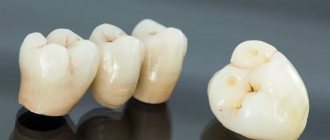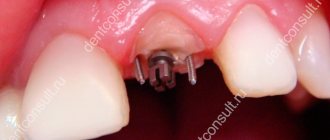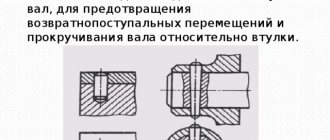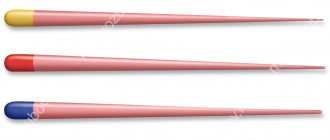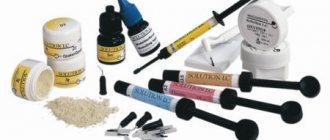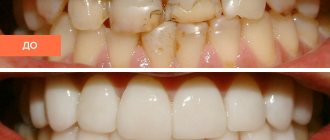Content
- Indications for stump restoration
- Formation of a tooth stump
- Dental prosthetics
- Care after crown installation
A tooth stump is a smaller version of a tooth onto which a crown is subsequently fixed. If there is enough natural tooth tissue, the stump can be easily formed using the preparation method. If there is not enough natural material, it is necessary to restore the stump under a prosthesis. There are several ways to do this.
PROMOTION
Installation of crowns, dental bridge
RUB 3,450
Implantation stage
Next, the chief physician of the Research Center, implant surgeon Magomed Umatgireevich Dakhkilgov, removed the patient’s failing teeth, atraumatically, with dissection of the roots. Were held:
- dental implantation on the upper and lower jaws using Nobel Parallel implants,
- sinus lift of the upper jaw,
- osteoplasty (bone grafting) on the lower jaw.
Now we will not go into the moment of implantation, but I would like to note that the implantation was carried out very extensively and with pinpoint precision, 14 Nobel implants were aligned according to a surgical template - 8 implants on the upper jaw and 6 implants on the lower jaw.
After the implantation was completed, we began prosthetics.
When is stump restoration required?
It is necessary to give the remaining tissues of the upper part of the tooth the desired shape in order to subsequently successfully secure the prosthesis - a crown or bridge. A properly shaped stump is required:
- After endodontic treatment, when tooth restoration with a filling or inlay is undesirable.
- In case of severe destruction of the crown, when restoration by other methods is impractical.
It is important to provide the crown with reliable support. In this case, the tooth root can be preserved for a long time.
Summary
So, the stump inlay for a tooth is a lifelong design. But there are many nuances, so the professionalism of specialists plays a key role. It is very important to properly prepare the tooth for taking an impression - sharpen the canals, treat the inside of the tooth with a Vaseline-based composition, correctly fill in quick-drying plastic mass to obtain an impression, etc. After taking an impression, the tooth canals are disinfected and a temporary filling is placed, since infection is fatal. The qualifications of the doctor making the crown are also important, and even more so the correctness and accuracy of the actions when installing the stump.
Tooth Fairy dentistry has been successfully using this technology for a long time; we help patients even in the most difficult situations. Waiting for you!
How does the stump form?
Several methods are used depending on the situation:
- Formation of a stump without a pin. This is possible if the tooth is not severely damaged and there is enough healthy tissue to provide reliable support for the crown.
- Creation of a stump supported by a pin. In this case, the channel, which was previously tightly sealed, expands and a pin is inserted into it. The pin is fixed to durable cement and serves to hold the material and compensate for the chewing load in the future.
- Installation of the stump tab. This approach is used when there is little native tissue and creating a stump from a composite material is impractical.
Pins and stump inlays: choice when restoring a tooth
The topic of restoring damaged teeth using a core insert is relevant both for endodontics and general dentistry. At the same time, each clinician has his own approach to achieving a successful treatment result using stump inlays, but be that as it may, the process of their use itself requires taking into account many important points. To facilitate the algorithm for such a restoration, factory-made, pre-prepared pins are often used, which optimize the process of restoring damaged tooth tissue. On the other hand, given the saturation of the market, it is difficult for a doctor to determine which system is the best for each individual clinical case. Although in fact the very definition of “the best pin” is at least a matter of debate. The more conservatively the clinician approaches root canal treatment, the greater the chance of achieving a positive treatment result and ensuring the long-term functioning of the restoration. This article analyzes methods of conservative root canal treatment and their relationship with promising clinically successful results of complex restoration of dental tissue.
Root Canal Access
Ultimately, the goal of endodontic treatment is to preserve the patient's tooth for as long as possible. Even with the doctor’s maximum desire to carry out endodontic treatment, he may encounter the problem that essentially there is not enough tooth tissue left to further perform any restoration.
Photo 1 shows access to the root canals through a zirconium crown, which was formed under limited conditions.
Photo 1. Limited access.
If the root canal access is too small, the following three problems arise:
- clinicians lack sufficient space to ensure effective cleaning of the root canal space;
- the risk of instrument breakage inside the root canal increases due to a lack of a direct path for file insertion;
- Some of the channels, if the access is too narrowed, may go unnoticed altogether.
When creating too much access, the dentist can provoke too much reduction of hard tissues, thereby compromising the functional prognosis of the entire tooth. Thus, the concept of consensus plays a very important role in endodontic practice. The most reasoned approach is to search and treat root canals under a microscope, in this way it is possible to minimize the volume of prepared tissue and ensure adequate visualization of the entire working field.
Types of pins
Dental restoration using pin structures can be carried out using factory pins, their cast analogues, or even fiberglass versions of the structures. The most biologically substantiated design is fiberglass pins, while metal ones remain the most popular. The latter are factory analogues of different sizes and shapes, which remain the cheapest and most accessible. Also, these pins are characterized by varying degrees of flexibility, which allows them to be used adapted in different clinical cases. The purpose of the pin structure is to restore the tooth stump. The latter can be restored using composite, metal, amalgam, thus ensuring a strengthening of the connection between the future coronal restoration and the residual natural tooth tissues.
Principles of pin placement
To form a successful restoration, it is necessary to take into account certain principles for installing pin structures.
These principles are a kind of recommendations, and require the clinician to take into account:
- amount of remaining tooth structure,
- quality of residual dental tissues,
- features of the structures adjacent to the tooth,
- specifics of occlusion and the presence of parafunctional habits,
- details of the future restoration.
Understanding these principles will allow clinicians to take a more individualized approach to each individual clinical restoration.
Amount of residual tooth structure
When assessing the amount of residual tooth structure, the golden rule applies: if more than half of the tooth tissue is missing, it is necessary to install a pin. The problem is different; it is necessary to assess whether there is enough residual tissue for adequate retention of the crown. This criterion is determined by the ferrule, which is essentially a 360-degree metal collar of the crown surrounding parallel dentin walls and extending from the coronal portion of the tooth to the shoulder of the preparation area. In some clinical situations, ferrule may be sufficient, but in others, its deficiency limits the possibilities of treatment. Under ideal conditions, to restore a tooth, it is necessary to have at least 3 mm of walls on one side and 2 mm on the other, which indicates the presence of a 2 mm ferrule. In such a case, the chance of achieving an adequate treatment option is quite high. If the ferrule parameters are deficient, the possibility of ensuring an effective outcome of the intervention also exists, but the doctor must understand the risk of developing potential complications in specific clinical cases.
Quality of residual tooth structure
When studying the quality of the tooth structure, the clinician must evaluate the so-called non-ideal conditions for restoration, such as existing discolourations, cracks, undercuts and various concavities. Typically, the latter are more common in premolars, but sometimes they can also be found in the molar area, such as on the distal surface of the lower teeth or on the palatal surface of the upper teeth. In this case, the pin must be installed in as straight a channel as possible. In the 5th tooth, this is predominantly the palatal canal, and only in whitening cases – the buccal canal. It all depends on the individual specifics of their morphology. Photo 2 shows a situation where the doctor treated caries and opened the pulp chamber. Considering that the buccal and lingual walls were intact, although not high, and the tooth structure still contained not only remnants of amalgam, but also cracks, all parameters indicate the need to install a pin. When restoring a tooth without a pin due to the presence of cracks, it would be simply impossible to predict functional changes in its structure, which could ultimately lead to its complete loss.
Photo 2. Minimum volume of residual walls.
Related structures
When a tooth is placed isolated in the dentition, it is subject to a large functional load, due to the absence of adjacent teeth that allow the functional stress to be distributed. Photo 3 shows an x-ray of a single tooth, in front of which it was planned to install 3 implants. At the same time, the clinician had to consider whether it would be possible to retain the given tooth until the implants achieve full integration. Photo 4 depicts a situation that will soon require the placement of a dental implant. For more than ten years, the patient had a functioning bridge, the edge of which, however, hung from the side of the premolar. The placement of the pin in this case was far from ideal, since it was installed only in the distal canal, and not all gutta-percha was removed from the endospace. Ensuring an accurate fit of the post to the walls of the tooth is one of the most important tasks of this type of restoration. Regardless of whether the doctor uses smooth pins or threaded pins, excess gutta-percha must be removed, since its structure is far from the density of the tooth structure. All this ultimately provokes an increase in the mobility of the pin, and as a result, an increase in the mobility of the entire prosthesis.
Photo 3. Single tooth.
Photo 4. Clinical case with the need for a dental implant in the future.
Photo 5 shows an interesting situation in which the apex of the tooth root remained in the socket after extraction. An anesthetized area was observed in the premolar area, which provoked pain. All this was complicated by the fact that the patient was a heavy smoker. He previously had three dental implants installed, but none of them took root. To compensate for the complications, the doctor installed a wider implant for the patient, but that one was unsuccessful. Thus, it turned out to be impossible to implement the concept of prosthetic rehabilitation using a bridge and sometimes implants. Therefore, it was decided to fix the prosthetic restoration on the molar and the opposite canine, but biomechanically this design was too long. The use of partial dentures at the patient's age was not very acceptable. In the end, the doctor and the patient came to the conclusion that it was best to preserve the existing bridge for as long as possible, and when it had to be removed, to restore the defect area with a partial prosthetic structure.
Photo 5. Remaining root after tooth extraction.
Photo 6 shows a root canal, which did not cause any pain in the patient, but did cause a feeling of discomfort. It would seem that there is nothing special in the picture. But the depth of probing of the patient’s tooth area demonstrated the presence of a 6 mm pocket, which suggested a suspicion of a crack in the tooth. In fact, the patient was later confirmed to have a buccal fracture of the mesial root. A certain amount of bone tissue was present apical to the fracture site, but bone support was completely absent coronally.
Photo 6. View of a successfully treated tooth.
During the treatment, root resection was performed, with augmentation of the socket with demineralized lyophilized bone, and covering the intervention area with a collagen membrane. The situation was certainly not ideal. It would be best to remove the existing bridge and install implants. But on the other hand, given that the previous four implants had already failed, I did not want to repeat the bitter experience of disintegration. Also, this type of treatment is also more expensive, which again, given the loss of the previous four implants, was not justified. The patient’s existing bridge functioned for 14 years, and after root resection it lasted another 5.5 years before finally breaking. The question of whether the additional five retentions were worth the restoration of all the above-mentioned problems remains only an individual one. Due to the fact that the pin was installed incorrectly, it provoked an increase in functional stress, which led to a fracture of the medial root.
Occlusal parameters of the restoration
Occlusion, as a rule, is most often not taken into account during endodontic treatment, although in fact it is one of the key factors determining the success of treatment. Patients who are bruxists and clenchers require a specific approach to endodontic treatment, taking into account the distribution of functionally applied forces. Photo 7 shows an x-ray of a patient with bruxism: the patient reacted to hot and cold stimuli, and there was a need to determine which tooth was actually reacting. The periapical radiograph indicated a problem in the area of tooth 2, tooth 3 had a crown, and tooth 4 had a huge restoration. So each could be a major problem. After performing bitewing radiography, it became obvious that in the area of the 3rd tooth there was a significant carious defect, which was not visualized on the periapical radiograph, and in the area of the 2nd tooth there was a periodontal defect and the presence of calcifications in the pulp chamber.
Photo 7. Bruxism.
In the area of the 30th tooth, an area of class V carious lesion was identified, the presence of a pin in the 31st tooth, and additionally it was possible to verify caries in the 2nd tooth. The pin available in 32 was essentially useless, since it did not correspond to the parameters of length, width, or size, but in general. If the pin is too short, the fulcrum increases, and with it the risk of fracture. If the pin is too long, the risk of fracture increases due to excessive potential bending. In addition, if the length of the pin is too short, it essentially does not serve any function in the tooth, and its biomechanical value is reduced to zero. In general, it is preferable to place pins in teeth that will receive a cemented single restoration. When fixing parts of a bridge to such teeth, the risk of potential iatrogenic complications increases several times.
Figure 8. A bitewing radiograph helped visualize the existing problems.
Taking into account the specifics of future restorations
Photo 9 shows a problematic situation with the 12th tooth, which, in principle, should be solved quite simply. However, during treatment, significant bleeding began. The reason for this could be either non-reversible pulpitis or root perforation. The radiograph showed damage to the distal root, which the doctor was able to restore using MTA (photo 10), after which endodontic treatment was successfully performed. After this, a pin of the appropriate length and width was installed in the root space of this tooth. Photo 11 shows the result of treatment 8.5 years after the intervention.
Photo 9. Clinical case, which was characterized by significant bleeding during treatment.
Photo 10. The initial result of the restoration was successful.
Photo 11. The tooth lasted another 8.5 years.
The patient consulted a doctor about the presence of sensitivity in the tooth, which progressed to pain, which required endodontic intervention. After the tooth was restored, it lasted another 9.25 years, after which the restoration finally broke. This case is special in that it demonstrates the possibility of restoring teeth even with the most critical defects and even in the most unfavorable clinical situations, while providing an almost 10-year successful treatment prognosis. In this particular situation, it was possible to save the tooth after restoration of the restoration area due to the presence of a sufficient ferrule that supported the coronal part of the restoration. In addition, the perforation was located not just below the level of the gums, but in the area adjacent to the bone tissue, which is also an advantageous factor for achieving the required therapeutic result.
Photo 12 shows an example of using a pin that is too long. No more than 1 mm of gutta-percha was present at the apical end of the root, while the proper length of the apical plug should be 4-5 mm. Photo 13 shows the situation of root resorption after endodontic treatment and placement of a pin. Such problems can be avoided by ensuring that the post installation procedure is performed by the same doctor who performed the endodontic treatment. Indeed, in this case, the doctor is already familiar with the specifics of the morphology of the root canal, and knows what length and width of the pin is best to use. In addition, it is important to ensure the installation of the pin after isolating the working area with a rubber dam, because saliva entering the root space over the years will cause the development of periapical changes that compromise the final outcome of treatment. The rules for installing a pin are based on achieving the required retention: the longer the pin, the greater the retention. In addition, it is important to ensure that the pin length corresponds to 2/3 of the root length, while not forgetting that 4-5 mm of gutta-percha in the apical part of the tooth is optimal to ensure proper sealing.
Photo 12. The pin is too long.
Photo 13. Tooth root resorption.
Photo 14 shows the situation of tooth restoration with a pin, inlay and crown. The threaded post used was too short for the tooth, so re-treatment became necessary. It is logical that it was necessary to remove the crown of the tooth. Given the patient's limited financial resources, the goal of the treatment was to keep the tooth in place for a certain time before the patient raised the appropriate amount for the installation of a dental implant or bridge. Thus, the tooth was removed, segmented, filled with MTA, then installed in the socket and sutured. After 2 weeks he showed adequate stability. Photo 15 shows an x-ray taken immediately after treatment, and photo 16 shows a radiograph taken 4.5 years later. Although the probing depth around the tooth increased from 3 to 4 mm, the achieved treatment result could be classified as successful, since it was possible to ensure tooth retention for a sufficient period of time.
Photo 14. The pin is too short.
Photo 15. X-ray after treatment.
Photo 16. X-ray after 4.5 years.
Pin diameter, texture and material
The choice of pin diameter and texture are important aspects to consider during treatment. It is necessary to ensure that the pin diameter is no more than 1/3 smaller than the root diameter, while leaving 1 mm of root dentin around the supporting element. Without taking these features into account, the risk of fracture increases. One millimeter of surrounding dentin is the minimum acceptable value, while 1.5 mm is ideal from a biomechanical point of view. In terms of texture, pins with a non-smooth surface provide better retention. In addition, pin designs can be sandblasted. An important element in the retention scheme is also the cement used for fixation. The best choice of these are composite and glass ionomer analogues. For very large or oval canals, especially in the maxillary anterior teeth, it is preferable to use custom casting pins and inlays. Factory pins are more suitable for round channels, and they are also cheaper. However, to provide more predictable results, especially in cases of restoration of multiple teeth with compromised structure, doctors are increasingly turning to cast customized posts. The diameter of the pin is determined by the diameter of the canal, but not by the diameter of the root. In very large canals, if the size of the pin or inlay is insufficient, they can simply scroll in the endospace. To minimize this effect, additional preparation procedures can also be performed.
As for the pin material, literature data indicate that fiberglass pins have greater flexibility and can minimize the risk of developing a vertical fracture. In addition, such pins are characterized by better aesthetic parameters, which is important for both anterior and posterior teeth. The problem with these pins is that they can get stuck in the measles space, and under such conditions it is quite difficult to remove them. For this purpose, you can use either a diamond bur or an ultrasonic attachment. But be that as it may, metal threaded pins are also quite difficult to remove, but in most cases this problem is solved using ultrasound. At the same time, glass fiber posts are characterized by a more adapted elasticity modulus, which is as close as possible to that of dentin. On an x-ray, such pins are visualized rather poorly. Photo 17 shows a clinical case using a fiberglass pin. When problems arise with teeth treated with fiberglass posts and sufficiently sealed in the endospace, pain problems are most easily resolved through an apicoectomy. In this way, it is possible to minimize both the volume of intervention and the risk of potential complications.
Photo 17. Visualization of the fiberglass pin.
Considering other parameters
When deciding whether to use a pin at all, the clinician must consider the influence of certain factors that determine the success of treatment in each individual clinical case. Photo 18 shows a case where the use of a pin was completely useless, and the parameters of the supporting structure did not correspond to the morphology of the canal walls. Photo 19 shows how the tooth looked without a post: signs of caries were noted, but there was still a chance to save the tooth. Photo 20 shows an x-ray after treatment, and photo 21 shows six months later.
Photo 18. The pin does not correspond to the parameters of the endospace.
Photo 19. View of the tooth without a pin.
Photo 20. X-ray after treatment.
Photo 21. X-ray after 6 months.
Further treatment of the tooth could follow two algorithms: (1) continue the doctor’s strategy, which consisted of further restoration of the tooth core from a composite, or (2) use a fiberglass pin. Another condition limiting the installation of a pin is the presence of signs of external or internal resorption. Photo 22 shows a tooth with signs of internal resorption. Today, such a pathology would of course be most easily identified by CBCT. In this case, the doctor filled the resorption area with gutta-percha, after which he completed the entire remaining coronal part with composite. Photo 23 shows a radiograph after treatment, and photo 24 shows a radiograph after 2 years. The only pin that could be installed in this case is fiberglass. To restore the supporting core of the tooth, the doctor can use different materials, but it is optimal to take into account the ratio of their parameters with the parameters of the tooth dentin. It is also important for the doctor to understand the clinical situation comprehensively, taking into account all the elements in three-dimensional space. Many may think that photo 25 shows a fairly good treatment result, unless, of course, the access cavity is taken into account. But in another section we see that this tooth is unsealed by approximately another 20%, which in turn indicates that the sealing of such a tooth is almost reduced by 100%. Thus, the analysis of the results of endodontic treatment is based only on data.
Photo 22. Internal resorption.
Photo 23. X-ray after treatment.
Photo 24. X-ray after 2 years.
Photo 25. Initial treatment results may appear acceptable.
If a patient experiences sensitivity after treatment that is difficult to explain, it may be helpful to have an additional CBCT scan to help visualize any “invisible” problem areas.
Photo 26. Detailed analysis can verify quality problems in endodontic treatment.
conclusions
Methods of pin placement, as well as the decision about the need for pin placement in principle, depend on the specific circumstances of each individual clinical situation. It is best to ensure a minimally invasive and as conservative approach to treatment as possible by choosing between a prefabricated post or a fiberglass post. In addition, clinicians must fully understand the basic principles of retention and enhancement of the connection between the post and the coronal restoration. Successful designs of pin-supported restorations must also consider their potential relationship with adjacent surrounding structures, as well as occlusal parameters, the impact of existing parafunctions on the final outcome, and the performance prospects of future restorations. The doctor should also not forget about the treatment goals that are important for the patient himself, as well as his financial capabilities. Thus, the choice of a pin and the rationale for its use are the result of a comprehensive analysis of the initial parameters, taking into account the success of the already performed endodontic intervention.
Author: Joseph Chikvashvili, DDS
Prosthetics
When the inlay is ready, a crown can be installed on it. If we are talking about the front part of the dentition and a crown made of ceramics or zirconium dioxide, the inlay should be light. Crowns made from these materials are as close in appearance to natural teeth as possible. They also have the required level of transparency. The metal stump insert will be visible through the ceramic layer. Therefore, it is important that the support meets aesthetic requirements. A composite stump based on a pin or an intraradicular stump made of zirconium dioxide can be used.
For prosthetics of chewing teeth, strength is much more important than aesthetics. In this area, metal ceramics are often used, for which the color of the stump is not important and the main role is played by its ability to withstand loads. When the stump is ready, an impression is taken of the jaw to make a model. Based on this model, a crown is subsequently made.
From the point of view of reliability, the option with prosthetics based on a stump intraradicular inlay is considered preferable. Reinforcement with pins is considered less reliable and is associated with the risk of destruction of the restoration.
Cast and collapsible tab: features
Cast structures have found greater use because they are easier to install and manufacture. A cast stump pin insert with a platform and pins is presented. The parts are permanently fixed to each other. Core inlays with a pin are a solution for the restoration of teeth with 1 root, as well as with 2 roots that have non-parallel canals.
A collapsible inlay is an option for teeth with 3-4 canals (cast is not suitable due to the risk of damage to tooth tissue). With high-quality manufacturing (there are nuances, you need to take into account the location of the pins), the collapsible inlay fits perfectly under the tooth and is installed without gaps.
Inlays are made from ceramics, an alloy of chromium and cobalt (CHC), gold, and metal. Ceramic inlays are mainly placed on the front teeth, and KHS alloy is used on the chewing teeth. Gold inlays are optimal because this metal does not oxidize and is not subject to destruction. Metal tabs are less popular and cause certain difficulties in manufacturing and installation.
Sign up for a consultation
Filling on a pin in different types of teeth
The advantages of the method lie in the integrity of the structure. If there are no moving or multi-layered parts, the structure appears more durable.
When installing a filling on a pin, there is no deformation or impact on the adjacent teeth in the row. Their enamel is not destroyed, the patient does not experience discomfort after the procedure.
The main disadvantages of the method include the formation of secondary caries. If the specialist used low-quality materials or paid little attention to the examination, then caries will form under the surface of the filling. The tooth is pigmented black, but the filling does not change.
A poor-quality filling in a tooth is clearly visible
What's better
It is quite difficult to say unequivocally which design to give preference to, since each of them has its own corresponding positive and negative sides. However, there are general requirements that apply to inlays and pins:
- Both products are installed only after the tooth has been depulped (the nerve is removed, the canals are filled).
- To ensure that the device is delivered to the highest possible quality, the canals are well healed.
- During the work process, the dentist uses the same techniques and tools.
Generally speaking, the tab has more advantages compared to the pin. Due to the fact that an indirect method is used to create an orthodontic element, it is more durable, which allows it to be used to restore dental units in the frontal and chewing zones.
The disadvantage of this design is that it takes more time to create than a pin, and installation is also considered difficult.
What exactly will be best is decided by the dentist individually for each patient. However, despite the high cost, the tabs are of higher quality, reliable and durable.
Installation of a tooth crown. Types of crowns and fixation methods
Dental crowns help restore the chewing function of the tooth and ensure full load. The method has a large number of indications for use:
- A strong tooth root, but a significant absence of the crown part. A pin is installed in the root, and an individual crown is fixed onto it.
- Strong enamel pigmentation that cannot be bleached. The indication may apply to several teeth at the same time.
- The presence of progressive non-carious dentin diseases.
- Abrasion of tooth enamel; destruction of enamel under the influence of exogenous or endogenous factors.
Differences
- The pin puts pressure on the root of the tooth, which can cause it to become loose; there is pressure on adjacent teeth, and the inlay eliminates this load.
- Time of use - the pin can be used for up to 3 years, the inlay - much longer, almost 10 years.
- The pin is a single design, but the tab can separate.
- It is not difficult to make a pin, but to make an inlay, laboratory specialists are involved and special studies are carried out.
- The installation of the pin is carried out in one visit to the dentist; to install the inlay, you will have to visit the doctor at least twice.
- If the tooth has a crooked root, you can only use an inlay.
- The cost of an inlay is significantly higher than a pin.
- Preparing the tooth for the installation of a pin is relatively gentle; in order to install the inlay, a large amount of tissue is removed.
